#kellaborn folklore
Text




been thinking about Kellaborn folk tales.
So, in order, we've got the legend of the moondrake, a great drake so hungry it ate the moons and stars. It was slain by a Kanai hero. Then we have the Smith and the Ruhk, which is a well-known folk song. Then we have the direrodi and the rodi, a fable about a direrodi that tries to tempt a loyal rodi into leaving its charges and joining its pack in the wild. Not sure where that goes yet, I'm thinking there are a few different endings. And finally we have the tale of a Medved' Beis that swallowed a whole village, but all the villagers just rebuilt their houses in her belly and kept living there forever. (human folk drawings of Kanai often depict them with four eyes)
19 notes
·
View notes
Note
Do Kanai and Humans have any similarly told folklore to each other?
Yes definitely! They share many of the same old stories. Sphinx too, and I'd venture to say sphinx probably bridge the cap between more often than not. Any folktales older than about 500 years are going to each have their own respective versions, essentially the same story but with different characters (Kanai replaced with humans or vice versa). There are many ancient stories featuring both, but Kanai and humans don't tell as many positive stories featuring each other anymore.
Kanai stories tend to focus on family and ferocity, the importance of loyalty, self-control, cleverness, forethought, and compassion. Kellaborn humans (both Gribi and Seivet) tell stories about adventure, bravery, death, overcoming hardships, weathering the wrath of the gods, and banding together against great calamities. There are some stories with commonalities between the two groups, but each group certainly has things they resonate with more.
3 notes
·
View notes
Text
Kellabor In a Nutshell
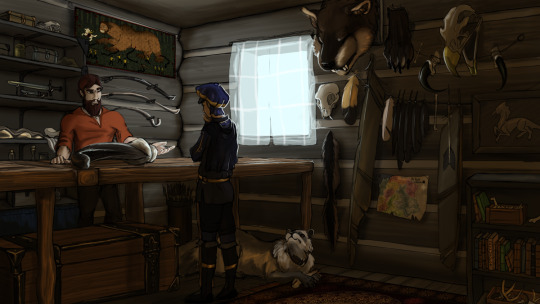
I'm realizing I've never put together all my Kellabor lore in one place for people to read, so here goes:
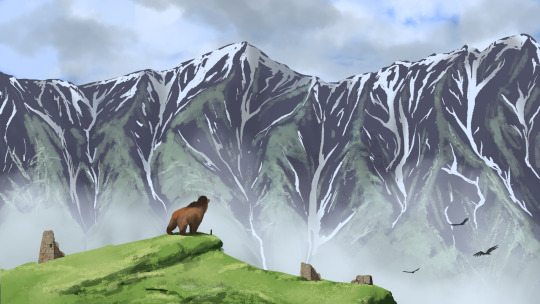
Kellabor:
Kellabor is a country in the southern hemisphere on a continent called Soria. It’s about the size of Mexico, maybe a bit smaller. The landscape is extremely mountainous and heavily forested, and the climate is analogous to western Canada (warm dry summer, cold wet winter). Culturally, it’s heavily inspired by Russia and Siberia. You’ll notice a lot of Russian words and names. You may also notice a lot of more western-European sounding names and culture. This is because Kellabor has historically had a strong trade history (along with some failed colonization attempts) by a country in the northern hemisphere called Rowea (which is more inspired by western Europe). People who are native to Kellabor are usually called “Gribi,” whereas people who have Rowean or other foreign ancestry are called “Seivet.” Gribi people are actually made up of several different ethnic groups that have banded together a bit more tightly as Seivet culture has started to become more widespread.
Humans:
Gribi have many old traditional beliefs and historically worship local minor gods and spirits. Most festivals and traditions revolve around the passage of seasons and paying respect to the animals and deities of the land. There’s a big emphasis on doing things like planting and honoring the spirits correctly and at the right times of year. The healer’s guild strictly adheres to these traditional Gribi values.
Seivet beliefs vary a lot, but most are “Heraldists,” a specific sect of Followers of the Luminous Child. They have integrated Gribi folklore into some of their beliefs, but are generally wary of “pagan” Gribi traditions. Churches in Kellabor are Heraldist congregations exclusively. Heraldism and The Old Ways agree on enough points to mostly get along, but leaders of congregations sometimes butt heads with Gribi leadership. Kellaborn children are usually taught to read by the local Heraldist priest, but most stewards (who are almost always Gribi and/or non-Heraldist) require said priests to use non-religious texts for teaching materials. This is often a matter of contention between local congregations and local government.
Lots of Gribi people convert to Heraldism, and plenty of Seivet people have left Heraldism behind and embraced local traditions, so there’s quite a mix of beliefs happening. There’s a lot of intermarrying and cultural mixing as well.
Calendar:
The people of this world have a 12 month, four season calendar with six day weeks. Every month has exactly 30 days. Every 4 years an extra day is added between the last and first days of the year. The days of the week are not named.
The “New Year” starts on the first of Yieldfrost, the rough equivalent of March and is considered the first day of spring.
The months of the year are shifted approximately 15 days before our months:
March: Yieldfrost
April: Leafbud
May: Newblossom
June: Broadleaf
July: Brightsun
August: Latebloom
September: Larderbrim
October: Tinderleaf
November: Baretree
December: Stonewater
January: Dimlight
February: Whiteveil
Ecology:
There are several large ungulates, including deer, elk, boar, dragon-elk (basically a giant six-legged elk), wisent (mountain bison), and tur (mountain goat). Other mammals include several squirrel species, kreezin (cave rats), zatel (fox), ermine, and bep (kind of like a pika). Large carnivores include bear (gilded bear, imagine like a grizzly bear but sort of yellow), fen cat (really just a big lynx), and direrodi (giant pack-hunting wolverines). There are a million birds, including quail, pheasant, dove, hawk, owl, eagle, and ruhk (giant eagles).
There are three dragon species: black-toothed drakes (big, cranky, and venomous opportunistic scavengers) and wild garjen (big shy herbivores) are flightless, four-legged, and non-firebreathing and are really only dragons in the taxonomical sense. Zargrum are coastal flighted dragons that dive for fish along the high Kellabor cliffs.
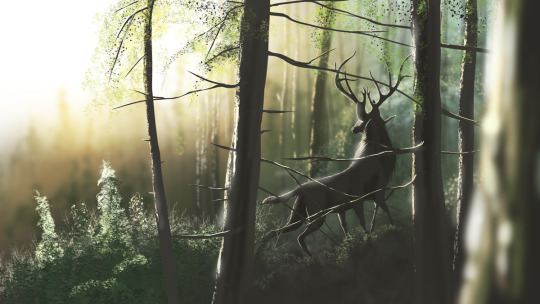
Non-human peoples:
There are two non-human peoples inhabiting Kellabor: sphinx and Kanai. In technical terms they are called “anthropoidal chimerics,” but only scholar-types refer to them as such.
Kellaborn sphinx look like snow leopards with snowy owl wings and a human face with ram’s horns. They’re big; think horse-sized. Culturally, they’re wanderers and nomads that travel alone or in small, casual groupings. Story-telling and knowledge-sharing are their great loves. They also like sleeping in the sun and tend to be extremely chill.
Kanai are essentially bear-sphinxes (grizzly bear body, human face, no wings or anything) and they’re stupid huge. House-sized. Like, eat-humans-whole-sized (which they have been known to do). Culturally, Kanai are hard-working land-tenders. They are extremely attuned to the ecosystem of a given area and their culture puts a huge emphasis on responsible harvest and forestry. They tend to live alone or in small, tightly-knit groups and hardly ever travel far from their home territories. Kanai have many yearly gatherings and festivals to reestablish bonds of family and friendship, and to trade stories and supplies. They very rarely fight seriously among each other.
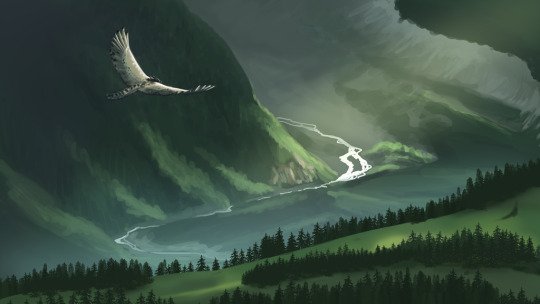
Humans relations to non-humans:
Sphinx are generally thought to be fierce and to encounter one is a great honor. They’re often seen in the distance on the wing, but few humans have ever been closer than that. To attempt harm on a sphinx is to incite the wrath of the gods. That being said, sphinx have been known to steal wegs on occasion, and some weg-drovers are resentful of their presence. Some tales of sphinx paint them as tricksters.
Sphinx enjoy mingling and swapping stories with Kanai and humans alike, but tend to keep a judicious distance. They’re very cryptic and cat-like in personality, but are generally friendly and have been known to help humans on occasion. They have a tendency to pop in and out of places as they please, so they come across as flaky and unreliable, but they do make long-term bonds and friendships and will return to their favorite people and places to catch up on the hot gossip.
All Kellaborn people have a deep respect for Medved’ Beis (which means “bear demon”) but also a great many myths about them. Plenty of people don’t believe they exist at all. Many believe talking about them or speaking their real name will summon them (this is why no one calls them “Kanai” anymore. Literally everyone stopped calling them that for a generation and everyone forgot the word). Gribi people believe Medved’ Beis are divine beasts sent by the gods to punish people who stray from the Old Ways, and are mostly very reverent. Seivet people are just scared shitless of them and don’t like to talk about it. Neither group has much real, factual understanding of Kanai.
Kanai are tolerant of humans at best. Mostly, Kanai keep to themselves and prefer humans to do the same. At worst, things get very ugly. They have a bit of an “eat first, ask questions later'' philosophy when it comes to competition for resources, which squarely puts humans on the menu. Kanai sometimes become habitual people-eaters in areas where trappers or hunters regularly encroach onto Kanai territory. In some regions of Kellabor, people-eating has become a part of important social traditions. It’s… rough. Smart humans stay out of the deep woods.
Plenty of humans are less than thrilled about Kanai. Rarely, if a particular Kanai is vulnerable enough or really particularly brazen about their people-eating, humans will band together in an attempt to kill them, with mixed success.
Economy:
Being depredated by Kanai so often has had an effect on the behavior of humans in Kellabor. The oldest cities and towns are ones that don’t have a negative effect on the environment around them, so most people have come to live in harmony with the landscape. People tend to clump close together and don’t spread out very much, leaving huge swaths of untouched wilderness. The population is fairly low and very stable (the human population of Kellabor stays very level, even with a relatively long life expectancy) so labor is valuable, and the working class actually has quite a lot of power compared to neighboring countries. Farmland is usually owned by the farmers who tend it, “wilderness” is considered owned by the public and is always available for trappers, hunters, and foragers to harvest on (if they dare), and although taxes are fairly high, it gets redistributed quickly in maintenance of roads, social services, a well-developed courier system, rangers, etc. There are several strong guilds, such as the blacksmith’s guild, healer’s guild, mason’s guild, and trapper’s guild, among others. The guilds maintain high standards for their members, enforce their own rules and regulations, and step in to help when there are financial difficulties. The actions of the guilds are carefully monitored by the state to ensure no one is becoming too powerful or taking advantage of the system.
Agriculture:
The people of Kellabor have a thriving economy based on agriculture and fur trade. Traditionally, they rely on terraced farming of vegetables like beets and cabbage, domestic garjen (horse drake things), and weg droving (sort of a wooly pig thing analogous to sheep). The Seivet people have introduced more land-intensive farming techniques as well as ryno (a wooly rhino that’s used similarly to oxen or cows). Quail and pheasant are commonly kept for food. Rodi (domestic wolverines) are kept for companionship, hunting, and herding.
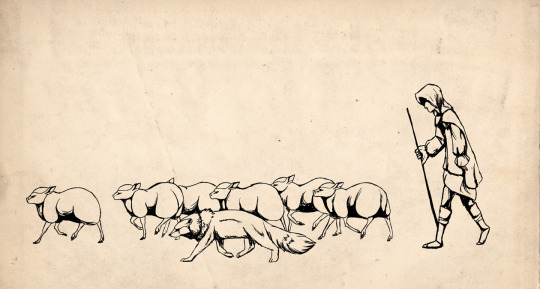
14 notes
·
View notes